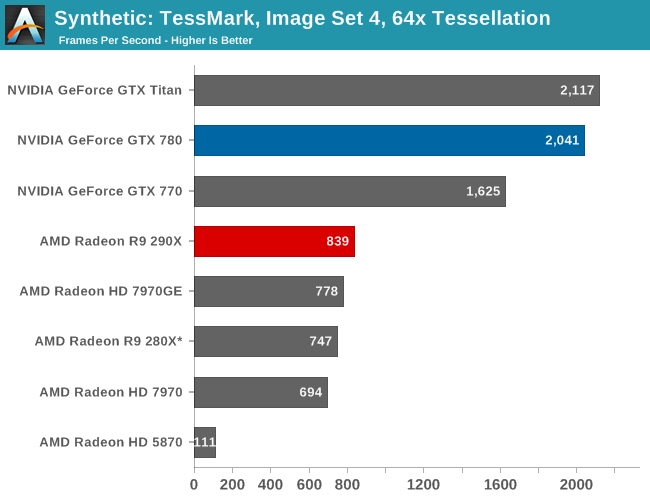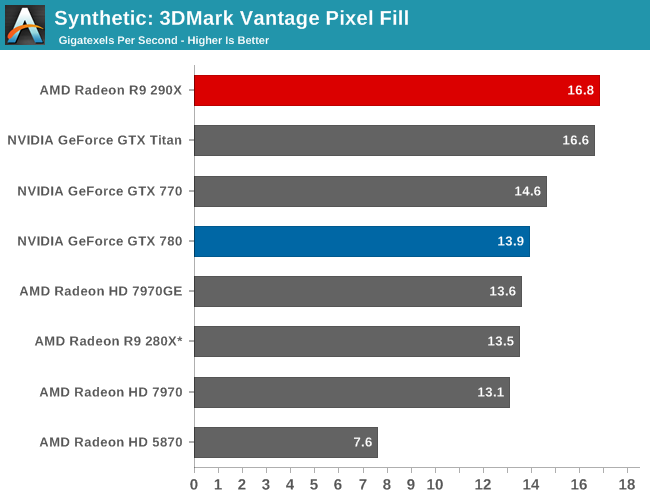The AMD Radeon R9 290X Review
by Ryan Smith on October 24, 2013 12:01 AM EST- Posted in
- GPUs
- AMD
- Radeon
- Hawaii
- Radeon 200
Synthetics
As always we’ll also take a quick look at synthetic performance. The 290X shouldn’t pack any great surprises here since it’s still GCN, and as such bound to the same general rules for efficiency, but we do have the additional geometry processors and additional ROPs to occupy our attention.

Right off the bat then, the TessMark results are something of a head scratcher. Whereas NVIDIA’s performance here has consistently scaled well with the number of SMXes, AMD’s seeing minimal scaling from those additional geometry processors on Hawaii/290X. Clearly Tessmark is striking another bottleneck on 290X beyond simple geometry throughput, though it’s not absolutely clear what that bottleneck is.
This is a tessellation-heavy benchmark as opposed to a simple massive geometry bencehmark, so we may be seeing a tessellation bottleneck rather than a geometry bottleneck, as tessellation requires its own set of heavy lifting to generate the necessary control points. The 12% performance gain is much closer to the 11% memory bandwidth gain than anything else, so it may be that the 280X and 290X are having to go off-chip to store tessellation data (we are after all using a rather extreme factor), in which case it’s a memory bandwidth bottleneck. Real world geometry performance will undoubtedly be better than this – thankfully for AMD this is the pathological tessellation case – but it does serve of a reminder of how much more tessellation performance NVIDIA is able to wring out of Kepler. Though the nearly 8x increase in tessellation performance since 5870 shows that AMD has at least gone a long way in 4 years, and considering the performance in our tessellation enabled games AMD doesn’t seem to be hurting for tessellation performance in the real world right now.
Moving on, we have our 3DMark Vantage texture and pixel fillrate tests, which present our cards with massive amounts of texturing and color blending work. These aren’t results we suggest comparing across different vendors, but they’re good for tracking improvements and changes within a single product family.

Looking first at texturing performance, we can see that texturing performance is essentially scaling 1:1 with what the theoretical numbers say it should. 36% better texturing performance over 280X is exactly in line with the increased number of texture units versus 280X, at the very least proving that 290X isn’t having any trouble feeding the increased number of texture units in this scenario.

Meanwhile for our pixel fill rates the results are a bit more in the middle, reflecting the fact that this test is a mix of ROP bottlenecking and memory bandwidth bottlenecking. Remember, AMD doubled the ROPs versus 280X, but only gave it 11% more memory bandwidth. As a result the ROPs’ ability to perform is going to depend in part on how well color compression works and what can be recycled in the L2 cache, as anything else means a trip to the VRAM and running into those lesser memory bandwidth gains. Though the 290X does get something of a secondary benefit here, which is that unlike the 280X it doesn’t have to go through a memory crossbar and any inefficiencies/overhead it may add, since the number of ROPs and memory controllers is perfectly aligned on Hawaii.










396 Comments
View All Comments
Antiflash - Thursday, October 24, 2013 - link
I've usually prefer Nvidia Cards, but they have it well deserved when decided to price GK110 to the stratosphere just "because they can" and had no competition. That's poor way to treat your customers and taking advantage of fanboys. Full implementation of Tesla and Fermi were always priced around $500. Pricing Keppler GK110 at $650+ was stupid. It's silicon after all, you should get more performance for the same price each year. Not more performance at a premium price as Nvidia tried to do this generation. AMD is not doing anything extraordinary here they are just not following nvidia price gouging practices and $550 is their GPU at historical market prices for their flagship GPU. We would not have been having this discussion if Nvidia had done the same with GK110.blitzninja - Saturday, October 26, 2013 - link
OMG, why won't you people get it? The Titan is a COMPUTE-GAMING HYBRID card, it's for professionals who run PRO apps (ie. Adobe Media product line, 3D Modeling, CAD, etc) but are also gamers and don't want to have SLI setups for gaming + compute or they can't afford to do so.A Quadro card is $2500, this card has 1 less SMX unit and no PRO customer driver support but is $1000 and does both Gaming AND Compute, as far as low-level professionals are concerned this thing is the very definition of steal. Heck, you SLI two of these things and you're still up $500 from a K6000.
What usually happens is the company they work at will have Quadro workstations and at home the employee has a Titan. Sure it's not as good but it gets the job done until you get back to work.
Please check your shit. Everyone saying R9 290X--and yes I agree for gaming it's got some real good price/performance--destroys the Titan is ignorant and needs to do some good long research into:
A. How well the Titan sold
B. The size of the compute market and MISSING PRICE POINTS in said market.
C. The amount of people doing compute who are also avid gamers.
chimaxi83 - Thursday, October 24, 2013 - link
Impressive. This cards beats Nvidia on EVERY level! Price, performance, features, power..... every level. Nvidia paid the price for gouging it's customers, they are going to lose a ton of marketshare. I doubt they have anything to match this for at least a year.Berzerker7 - Thursday, October 24, 2013 - link
Sounds like a bot. The card is worse than a Titan on every point except high resolution (read: 4K), including power, temperature and noise.testbug00 - Thursday, October 24, 2013 - link
Er, the Titan beats it on being higher priced, looking nicer, having a better cooler and using less power.even in 1080p a 290x approxs ties (slightly ahead according to techpowerup (4%)) the Titan.
Well, a $550 card that can tie a $1000 card in a resolution a card that fast really shouldn't be bought for (seriously, if you are playing in 1200p or less there is no reason to buy any GPU over $400 unless you plan to ugprade screens soon)
Sancus - Thursday, October 24, 2013 - link
The Titan was a $1000 card when it was released.... 8 months ago. So for 8 months nvidia has had the fastest card and been able to sell it at a ridiculous price premium(even at $1000, supply of Titans was quite limited, so it's not like they would have somehow benefited from setting the price lower... in fact Titan would probably have made more money for Nvidia at an even HIGHER price).The fact that ATI is just barely matching Nvidia at regular resolutions and slightly beating them at 4k, 8 months later, is a baseline EXPECTATION. It's hardly an achievement. If they had released anything less than the 290X they would have completely embarrassed themselves.
And I should point out that they're heavily marketing 4k resolution for this card and yet frame pacing in Crossfire even with their 'fixes' is still pretty terrible, and if you are seriously planning to game at 4k you need Crossfire to be actually usable, which it has never really been.
anubis44 - Thursday, October 24, 2013 - link
The margin of victory for the R9 290X over the Titan at 4K resolutions is not 'slight', it's substantial. HardOCP says it's 10-15% faster on average. That's a $550 card that's 10-15% faster than a $1000 card.What was that about AMD being embarassed?
Sancus - Thursday, October 24, 2013 - link
By the time more than 1% of the people buying this card even have 4k monitors 20nm cards will have been on sale for months. Not only that but you would basically go deaf next to a Crossfire 290x setup which is what you need for 4k. And anyway, the 290x is faster only because it's been monstrously over clocked beyond the ability of its heatsink to cool it properly. 780/Titan are still far more viable 2/3/4 GPU cards because of their superior noise and power consumption.All 780s overclock to considerably faster than this card at ALL resolutions so the gtx 780ti is probably just an OCed 780, and it will outperform the 290x while still being 10db quieter.
DMCalloway - Thursday, October 24, 2013 - link
You mention monstrously OC'ing the 290x yet have no problem OC'ing the 780 in order to create a 780ti. Everyone knows that aftermarket coolers will keep the noise and temps. in check when released. Let's deal with the here and now, not speculate on future cards. Face it; AMD at least matches or beats a card costing $100 more which will cause Nvidia to launch the 780ti at less than current 780 prices.Sancus - Thursday, October 24, 2013 - link
You don't understand how pricing works. AMD is 8 months late to the game. They've released a card that is basically the GTX Titan, except it uses more than 50W more power and has a bargain basement heatsink. That's why it's $100 cheaper. Because AMD is the one who are far behind and the only way for them to compete is on price. They demonstrably can't compete purely based on performance, if the 290X was WAY better than the GTX Titan, AMD would have priced it higher because guess what, AMD needs to make a profit too -- and they consistently have lost money for years now.The company that completely owned the market to the point they could charge $1000 for a video card are the winners here, not the one that arrived out of breath at the finish line 8 months later.
I would love for AMD to be competitive *at a competitive time* so that we didn't have to pay $650 for a GTX 780, but the fact of the matter is that they're simply not.